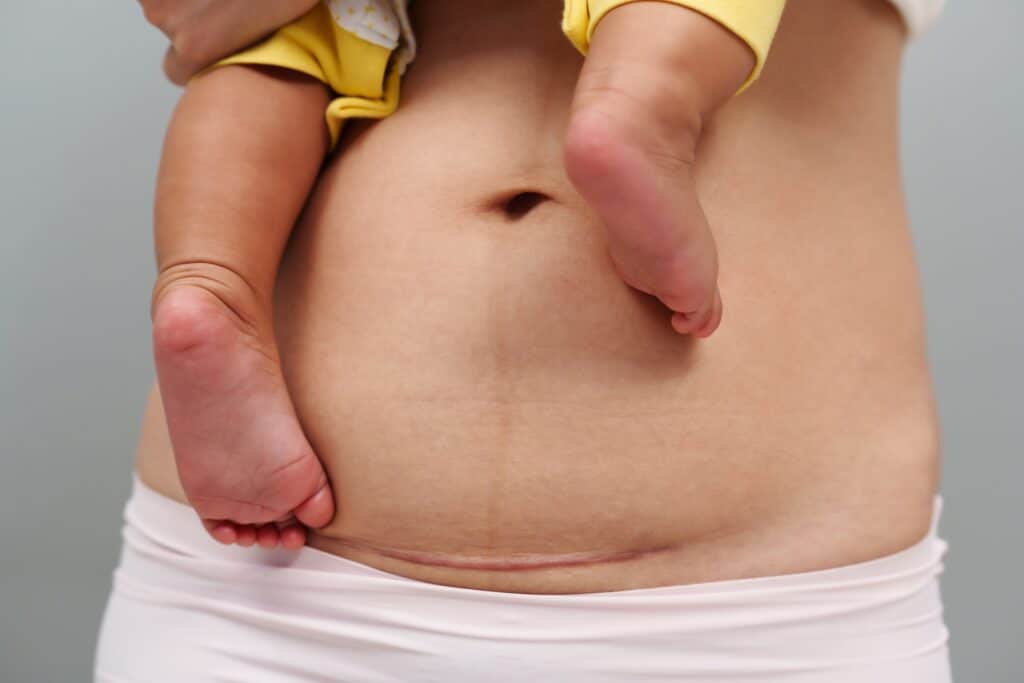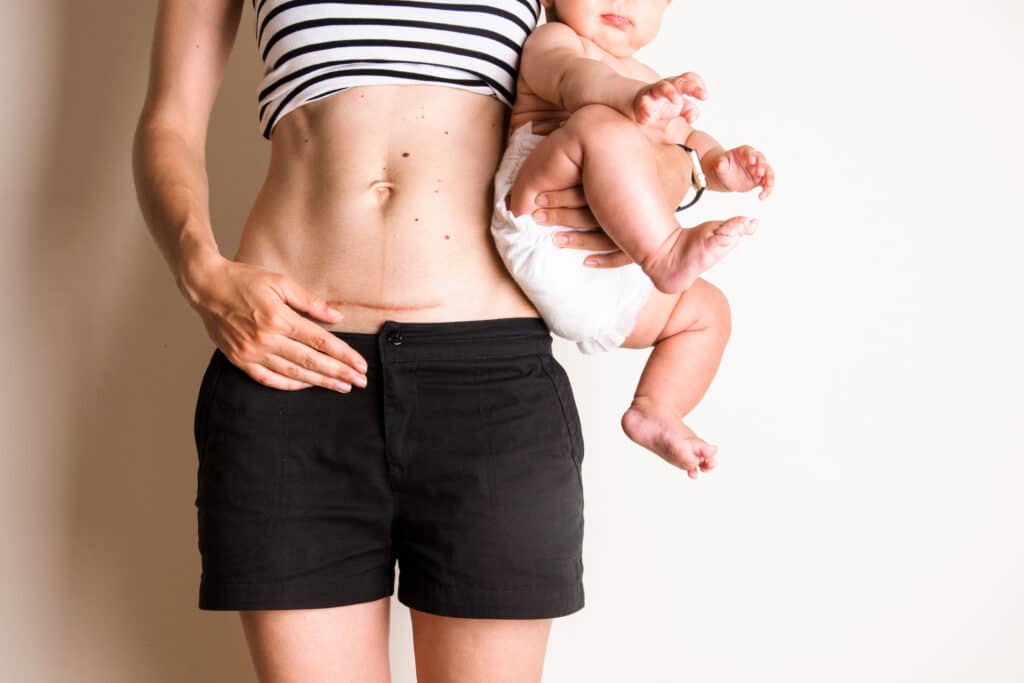“Her birth was simultaneously the most emotional, difficult and joyful experience of our lives.”
At the heart of every birth is the health and well-being of the mother and child.
While that often means different things for different parents, most expecting mothers — with the support of their medical team — will be asked to decide between having a vaginal birth or a C-section.
It’s a decision millions of mothers are faced with every year — and one that isn't taken lightly.
RELATED: Kylie Kelce stresses the importance of being honest during pregnancy
If you’re expecting a baby or planning on having a child at some point in the future, there’s a good chance you’ve wondered which delivery method would be best for you and your family.
And with April being Cesarean Awareness Month, there’s no better time to talk about it than right now.
Here are some of the facts to help you better understand what this procedure is and why it exists.
What is a C-section?

A C-section, also known as a cesarean section, is “a surgical procedure in which your baby is delivered through incisions in your abdomen and uterus,” according to the Cleveland Clinic.
Instead of being delivered through the birth canal, the baby is delivered through the lower abdomen.
According to Dr. Ian Askew of the World Health Organization (WHO), C-sections can be life-saving.
“Caesarean sections are absolutely critical to save lives in situations where vaginal deliveries would pose risks, so all health systems must ensure timely access for all women when needed,” Askew says.
According to 2022 data by the U.S. Centers for Disease Control and Prevention (CDC), nearly 1.18 million mothers chose (or were recommended) to undergo a C-section when delivering their baby.
That was compared to the nearly 2.49 million mothers who experienced a vaginal birth, per the CDC.
When is a C-section necessary?

Experts and doctors agree that a vaginal birth is safer for both the mother and child in most cases.
With that said, some mothers aren’t able to safely deliver a baby vaginally (due to medical restrictions) and others might not feel comfortable with a vaginal birth (due to personal preference).
For these mothers, a C-section is often the best alternative.
According to Keith Duncan, a consultant obstetrician who has delivered more than 3,000 babies during his career, the most common reason for a doctor-recommended C-section is placenta previa.
This occurs “when the placenta completely or partially covers the opening of the uterus (cervix),” per the Mayo Clinic.
Here are a few other common reasons a doctor might suggest a cesarean delivery, per Alberta Health:
- The mother is carrying more than one child (twins, triplets, etc.)
- The mother has a health issue that could worsen during labor
- The baby isn’t in a head-down position as the due date nears
- The mother has an infection that could be passed to the baby
- The mother has had a C-section or surgery on their uterus in the past
Likewise, here are some of the most common reasons why mothers might request a cesarean section:
- Fear or anxiety of labor pain or childbirth, in general
- Fear of triggering pelvic floor problems, such as urinary incontinence
- Wanting control over the due date of the baby
- Wanting control over who delivers the baby (primary doctor vs. on-call doctor)
- Being shy or embarrassed of the childbirth process
- Bad experiences with past deliveries
- Fear of a lack of support from medical team and staff
Either way, every mother has the right to understand the possible pros and cons of having a C-section — so don’t be afraid to ask questions and voice your concerns with your doctor and support system.
Planned vs. unplanned cesarean section
While some C-sections are planned (or scheduled) in advance, others are done out of an emergency.
At the end of the day, it all boils down to what’s best for the mother and baby. And that’s why doctors only make this decision when the mother or baby is in dire stress and immediate delivery is the only option.
Here are some of the most common reasons for an emergency C-section, according to WebMD:
- The placenta peels away from the wall of the uterus
- The umbilical cord drops through your cervix into the vagina
- The mother, baby or both are in distress
- The uterus tears along a previous C-section scar
- Labor isn’t progressing fast enough or contractions are too weak
- The baby isn’t tolerating labor
- The baby isn’t positioned properly when labor begins
An unplanned (or emergency) C-section can be a difficult experience for any mother — especially those who were planning on having a vaginal birth.
Traditional C-section vs. gentle C-section
Once the procedure is planned, the mother will have to choose between a traditional or gentle C-section.
In a traditional C-section, an opaque drape is pulled across the mother’s midsection so that, in addition to not feeling the procedure, they can’t see it either.
This can be a problem for some mothers who want to see their baby being born — like a vaginal birth.
That’s where a “gentle” C-section comes into play.
As explained by UT Southwestern Medical Center, a “gentle” cesarean section uses “a clear drape or a drape that has a clear window” to allow the mother to get that first glance of their baby.
Though not a replacement for vaginal births, a “gentle” C-section helps make the experience as traditional as possible for those unable to have a safe and healthy vaginal birth.
With that said, it’s important to understand that not all mothers are candidates for a “gentle” C-section.
What to expect from a cesarean delivery

Knowing what to expect from a C-section before undergoing one can help reduce the fear of what’s next.
For starters, the entire procedure typically takes 45-60 minutes, though the baby is usually delivered within the first 5-15 minutes. The remaining time is spent closing the incisions and monitoring health.
Since most C-sections use regional anesthesia, mothers are often awake but pain-free.
The recovery process generally takes 4-6 weeks — though the emotional recovery timeline may take longer — and often begins with a one- or two-night stay in the hospital to continue monitoring vitals.
Let’s take a closer look at what to expect before, during and after a C-section procedure.
Preparing for a C-section
The preparation process for a planned C-section often begins several weeks before the due date.
What that process looks like will vary for each mother, but directions will be given by the doctor leading up to the procedure — and a pre-operative appointment often takes place one week prior.
Undergoing a C-section
The preparation process continues once the mother arrives at the hospital on surgery day.
According to Jill Johnson, a registered nurse and childbirth education coordinator at Texas Health Presbyterian Hospital, this process often varies depending on why the mother is having a C-section.
“Pre-op consists of cleansing and sterilizing the abdominal surgical area, the placement of a catheter tube into your bladder to collect urine and the placement of an IV in your hand or arm,” Johnson explains.
Mothers are also hooked up to a monitor to report vital signs throughout the procedure.
As for the actual procedure, it usually takes about 5-15 minutes.
“The obstetrician will make an incision in your abdomen about as long as your middle finger and then more internal incisions to allow for baby’s delivery,” says Sheri Puffer, M.D., an OB/GYN at Texas Health.
Recovering from a C-section
Much like the procedure itself, recovering from a C-section will vary depending on the individual.
For the first few hours after surgery, the mother and baby will be sent to a recovery room where pain levels and vital signs are monitored by a member of the nursing staff.
“During the recovery-room period, we also encourage moms to initiate skin-to-skin contact with their babies to begin the bonding process,” says Johnson, per Texas Health.
Beyond that, the recovery process generally consists of pain management, keeping the incision site clean and dry and maintaining communication with your health care provider.
Your doctor will give you a set of post-op instructions to follow to avoid any complications from surgery.
Common side effects include headaches, shivering, backaches, soreness or itching where the epidural was inserted, nausea and/or some postpartum swelling — all of which can be treated with medication.
Overall, the recovery process generally takes anywhere between 6-8 weeks.
C-section recovery tips for partners

The mother’s partner and family play a special role in the recovery process.
They’re not only asked to provide physical support (due to the mobility restrictions from surgery), but also emotional support as they grapple with the mental effects of surgery.
Plus, postpartum depression is a real thing for new mothers — even after a C-section.
With that said, here are some specific ways partners can help with the mother’s recovery:
- Take over household responsibilities, such as cleaning, cooking, shopping, etc.
- Manage visitors to prevent the mother from becoming overwhelmed during early recovery
- Keep track of medications and help her remember when to take pain relievers
- Assist with baby care including diaper changes, bathing, and soothing the baby
- Help with positioning for breastfeeding as the incision site will be tender
- Be patient and understanding about mood swings caused by hormonal changes
- Listen actively to her concerns and validate her feelings
- Encourage rest even when she feels she should be doing more
- Celebrate small victories in her recovery process
Partners should be ready to ask for medical help if the mother has a fever, an increase in pain, redness, swelling or discharge at the incision site, heavy bleeding, severe headaches or difficulty breathing.
As for mothers, it’s best to follow the 5-5-5 postpartum rule for at least the first two weeks.
The 5-5-5 rule suggests spending five days in bed (focusing on rest), five days on the bed (sitting up), and five days around the bed (light activity), for a total of 15 days of gentle, progressive recovery.
FAQ about cesarean sections

It’s okay to have questions about the procedure — and mothers are encouraged to ask them as needed.
YOU MAY ALSO LIKE: Expert parenting advice for supporting teens through the college admissions process
After all, a cesarean section is a major surgery combined with the life-changing event of welcoming a new child. Mothers undergoing a C-section shouldn’t have any doubt or worry that it’s what’s best for them.












